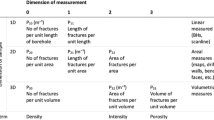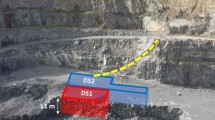Abstract
The spacing distribution of natural joints or fractures in rock masses affects the rock mass deformability, strength and transport properties according to their size, distribution in space, deformability and strength. Rock block sizes formed by intersecting joints are also an important engineering parameter influencing the behavior of rock masses around underground openings and surface excavations, extraction of blocks of commercial sizes of decorative stones and in rock fragmentation processes by blasting or mechanical excavation techniques. The rock block shapes and sizes are depicted by the number of joint sets, as well as orientation in space, persistence and spacings of joint sets transecting the rock mass. In this paper, we first elaborate on a new generalized Poisson probability density function of joint frequencies counted along scanlines and boreholes. Based on this probability density function we construct an algorithm for the estimation of joint spacings distribution from joint frequency measurements along scanlines. The validation of the conversion of joint frequencies to joint spacings is performed with the Monte-Carlo simulation technique. Joint count data along with drill cores from a white dolomitic marble quarry transected by three joint sets is used to demonstrate the application of the proposed algorithm. The proposed model and associated algorithm are necessary for the subsequent prediction of rock block volume distribution isolated between mutually intersecting joints. In this context among other applications they may find many applications in Discrete Fracture Network (DFN) modelling of jointed rock masses.
















Similar content being viewed by others
Abbreviations
- cdf:
-
Cumulative distribution function
- DFN:
-
Discrete fracture networks
- DTM:
-
Digital terrain model
- FF:
-
Fracture frequency (m−1)
- \(f_{\lambda }\) :
-
Number of fractures of the same joint set per fixed length interval along scanline or rock core (m−1)
- HPP:
-
Homogeneous Poisson process
- NHPP:
-
Non-homogeneous Poisson process
- LEFM:
-
Linear elastic fracture mechanics
- pdf:
-
Probability density function
- RV:
-
Random variable
- \(s\) :
-
Apparent joint spacing (m)
- \(\hat{s}\) :
-
True joint spacing (m)
- x :
-
Sampling length (or sample support) (m)
- \(\lambda\) :
-
Linear fracture frequency (or intensity) parameter (m−1)
References
Annavarapu S, Kemeny J, Dessureault S (2012) Joint spacing distributions from oriented core data. Int J Rock Mech Min Sci Geomech Abstr 52:40–45
Bardsley WE, Major TJ, Selby MJ (2012) Note on a Weibull property for joint spacing analysis. Int J Rock Mech Min Sci Geomech Abstr 27(2):133–134
Billaux D, Chilès J-P, Hestir K, Long J (1989) Three-dimensional statistical modelling of a fractured rock mass–an example from the Fanay-Augéres mine. Int J Rock Mech Min Sci Geomech Abstr. 26(3,4):281–299
Chilès J-P, Delfiner P (1999) Geostatistics: modeling spatial uncertainty. John Wiley & Sons Inc, New York
Dershowitz WS, Herda HH (1992) Interpretation of fracture spacing and intensity. In: Proceedings of the 33th U.S. Symposium on rock mechanics. A.A. Balkema
Dips v6.0 (2016) Graphical and Statistical Analysis of Orientation Data. Rocscience, https://www.rocscience.com/software/dips
Hudson JA, Priest D (1979) Discontinuities and rock mass geometry. Int J Rock Mech Min Sci 16:339–362
Hudson JA, Priest D (1983) Discontinuity frequency in rock masses. Int J Rock Mech Min Sci 20(2):73–89
(1975) International Society for Rock Mechanics (ISRM), commission on terminology, symbols and graphic representation, terminology. Int Soc Rock Mech secretary, Lisbon
(1978) International Society for Rock Mechanics (ISRM), Commission on standardization of laboratory and field tests: suggested methods for the quantitative description of discontinuities in rock masses. Int J Rock Mech Min Sci & Geomech Abstr 15(6): 319–368
Li S, Feng X-T, Li Z, Zhang C, Chen B (2012) (2012) Evolution of fractures in the excavation damaged zone of a deeply buried tunnel during TBM construction. Int J Rock Mech Min Sci 55:125–138
Miyoshi T, Elmo D, Rogers S (2018) Influence of data analysis when exploiting DFN model representation in the application of rock mass classification systems. J Rock Mech & Geotech Eng 10:1046–1062
Papoulis A (1991) Probability, random variables and stochastic processes, 3rd edn. Mcgraw-Hill College, London
Priest SD (1993) Discontinuity analysis for rock engineering. Chapman and Hall, London
Priest D, Hudson JA (1976) Discontinuity spacings in rock. Int J Rock Mech Min Sci 13:135–148
Ross SM (1993) Introduction to probability models, 5th edn. Academic Press Inc., New York
Rouleau A, Gale JE (1985) Statistical characterization of the fracture system in the Stripa Granite, Sweden. Int J Rock Mech Min Sci Geomech Abstr 22(6):353–367
Schlotfeldt P, Elmo D, Panton B (2018) Overhanging rock slope by design: an integrated approach using rock mass strength characterisation, large-scale numerical modelling and limit equilibrium methods. J Rock Mech & Geotech Eng 10(1):72–90
Stavropoulou M (2014) Discontinuity frequency and block volume distribution in rock masses. Int J Rock Mech & Min Sci 63:62–74
Stavropoulou M, Xiroudakis G (2020) Fracture frequency and block volume distribution in rock masses. Rock Mech Rock Eng 53:4673–4689. https://doi.org/10.1007/s00603-020-02172-6
Wines DR, Lilly PA (2002) Measurement and analysis of rock mass discontinuity spacing and frequency in part of the Fimiston Open Pit operation in Kalgoorlie Western Australia: a case study. Int J Rock Mech Mining Sci 39:589–602
Yakovlev G, Rundle JB, Shcherbakov R, Turcotte DL (2014) Inter-arrival time distribution for the non-homogeneous Poisson process, paper uploaded by Robert Shcherbakov on 10 March 2014
Acknowledgements
The financial support by the Programme “Marble resources estimation based on oriented drill core data (MARBLECORE)” under Contract No. AMΘΡ2-0016310 is kindly acknowledged here.
Author information
Authors and Affiliations
Corresponding author
Additional information
Publisher's Note
Springer Nature remains neutral with regard to jurisdictional claims in published maps and institutional affiliations.
Rights and permissions
About this article
Cite this article
Stavropoulou, M., Saratsis, G., Xiroudakis, G. et al. Derivation of the Discontinuity Spacings Distribution from Frequency Data Along Scanlines and Boreholes. Rock Mech Rock Eng 54, 3095–3113 (2021). https://doi.org/10.1007/s00603-021-02442-x
Received:
Accepted:
Published:
Issue Date:
DOI: https://doi.org/10.1007/s00603-021-02442-x




